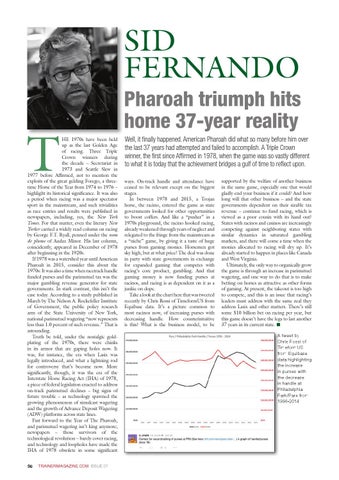SID FERNANDO
T
HE 1970s have been held up as the last Golden Age of racing. Three Triple Crown winners during the decade – Secretariat in 1973 and Seattle Slew in 1977 before Affirmed, not to mention the exploits of the great gelding Forego, a threetime Horse of the Year from 1974 to 1976 – highlight its historical significance. It was also a period when racing was a major spectator sport in the mainstream, and such trivialities as race entries and results were published in newspapers, including, yes, the New York Times. For that matter, even the literary New Yorker carried a widely read column on racing by George F.T. Ryall, penned under the nom de plume of Audax Minor. His last column, coincidently, appeared in December of 1978 after beginning in the 1920s. If 1978 was a watershed year until American Pharoah in 2015, consider this about the 1970s: It was also a time when racetrack handle funded purses and the parimutuel tax was the major gambling revenue generator for state governments. In stark contrast, this isn’t the case today. According to a study published in March by The Nelson A. Rockefeller Institute of Government, the public policy research arm of the State University of New York, national parimutuel wagering “now represents less than 1.0 percent of such revenue.” That is astounding. Truth be told, under the nostalgic goldplating of the 1970s, there were chinks in its armor that are gaping holes now. It was, for instance, the era when Lasix was legally introduced, and what a lightning rod for controversy that’s become now. More significantly, though, it was the era of the Interstate Horse Racing Act (IHA) of 1978, a piece of federal legislation enacted to address on-track parimutuel declines – big signs of future trouble – as technology spawned the growing phenomenon of simulcast wagering and the growth of Advance Deposit Wagering (ADW) platforms across state lines. Fast forward to the Year of The Pharoah, and parimutuel wagering isn’t king anymore; newspapers – those survivors of the technological revolution – barely cover racing, and technology and loopholes have made the IHA of 1978 obsolete in some significant 96
TRAINERMAGAZINE.COM ISSUE 37
Pharoah triumph hits home 37-year reality Well, it finally happened. American Pharoah did what so many before him over the last 37 years had attempted and failed to accomplish. A Triple Crown winner, the first since Affirmed in 1978, when the game was so vastly different to what it is today that the achievement bridges a gulf of time to reflect upon. ways. On-track handle and attendance have ceased to be relevant except on the biggest stages. In between 1978 and 2015, a Trojan horse, the racino, entered the game as state governments looked for other opportunities to boost coffers. And like a “pusher” in a 1970s playground, the racino hooked racing, already weakened through years of neglect and relegated to the fringe from the mainstream as a “niche” game, by giving it a taste of huge purses from gaming monies. Horsemen got sky high, but at what price? The deal was done in party with state governments in exchange for expanded gaming that competes with racing’s core product, gambling. And that gaming money is now funding purses at racinos, and racing is as dependent on it as a junkie on dope. Take a look at the chart here that was tweeted recently by Chris Rossi of TimeformUS from Equibase data. It’s a picture common to most racinos now, of increasing purses with decreasing handle. How counterintuitive is this? What is the business model, to be
supported by the welfare of another business in the same game, especially one that would gladly end your business if it could? And how long will that other business – and the state governments dependent on their sizable tax revenue – continue to fund racing, which is viewed as a poor cousin with its hand out? States with racinos and casinos are increasingly competing against neighboring states with similar dynamics in saturated gambling markets, and there will come a time when the monies allocated to racing will dry up. It’s already started to happen in places like Canada and West Virginia. Ultimately, the only way to organically grow the game is through an increase in parimutuel wagering, and one way to do that is to make betting on horses as attractive as other forms of gaming. At present, the takeout is too high to compete, and this is an issue that racing’s leaders must address with the same zeal they address Lasix and other matters. There’s still some $10 billion bet on racing per year, but this game doesn’t have the legs to last another 37 years in its current state. ■ A tweet by Chris Rossi of TimeformUS from Equibase data highlighting the increase in purses with the decrease in handle at Philadelphia Park/Parx from 1996-2014
